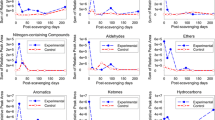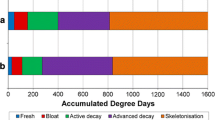Abstract
Decomposition odour and volatile organic compounds (VOCs) have gained considerable attention recently due to their use by insects and scent detection canines to locate remains. However, a comprehensive and accurate profile of decomposition odour is yet to be confirmed. This is, in part, due to the geographical diversity in the studies conducted and the variation in the methodology and compounds being reported. To date, no repeatability studies of decomposition odour have been conducted in the same environment. In order to address this current gap in the scientific literature, this study conducted three replicate trials in order to evaluate the inter-year repeatability of the decomposition VOC profile in a southern Canadian environment. Surface decomposition trials were conducted during the spring and summer months and the VOCs were analysed by thermal desorption–gas chromatography–mass spectrometry (TD–GC–MS). This study was able to demonstrate that decomposition VOCs are produced consistently during their characteristic stages and that this relationship is maintained under varying environmental factors which influence the rate of decomposition. This consistent production of decomposition VOCs can lead to a better understanding of the mechanisms of soft tissue decomposition and their sources of variation, and it could potentially lead to improved applications of these compounds for the detection of decomposed remains.






Similar content being viewed by others
References
Boumba VA, Ziavrou KS, Vougiouklakis T (2008) Biochemical pathways generating post-mortem volatile compounds co-detected during forensic ethanol analyses. Forensic Sci Int 174(2–3):133–151
Dent BB, Forbes SL, Stuart BH (2004) Review of human decomposition processes in soil. Environ Geol 45:576–585
Gill-King H (1997) Chemical and ultrastructural aspects of decomposition. In: Haglund WD, Sorg MH (eds) Forensic taphonomy: The postmortem fate of human remains. CRC Press, New York, pp 93–108
Paczkowski S, Schutz S (2011) Post-mortem volatiles of vertebrate tissue. Appl Microbiol Biotechnol 91(4):917–935
Vass AA, Smith RR, Thompson CV, Burnett MN, Wolf DA, Synstelien JA, Dulgerian N, Eckenrode BA (2004) Decompositional odor analysis database. J Forensic Sci 49(4):760–769
Dekeirsschieter J, Verheggen FJ, Gohy M, Hubrecht F, Bourguignon L, Lognay G, Haubruge E (2009) Cadaveric volatile organic compounds released by decaying pig carcasses (Sus domesticus L.) in different biotopes. Forensic Sci Int 189(1–3):46–53
Stadler S, Stefanuto PH, Brokl M, Forbes SL, Focant JF (2013) Characterization of volatile organic compounds from human analogue decompsoition using thermal desorption coupled to comprehensive two-dimensional gas chromatography – time-of-flight mass spectrometry. Anal Chem 85(2):998–1005
DeGreeff LE, Weakley-Jones B, Furton KG (2012) Creation of training aids for human remains detection canines utilizing a non-contact, dynamic airflow volatile concentration technique. Forensic Sci Int 217:32–38
Dekeirsschieter J, Stefanuto PH, Brasseur C, Haubruge E, Focant JF (2012) Enhanced Characterization of the smell of death by comprehensive two-dimensional gas chromatography–time-of-flight mass spectrometry (GC × GC–TOFMS). PLoS One 7(6):e39005
Statheropoulos M, Agapiou A, Zorba E, Mikedi K, Karma S, Pallis GC, Eliopoulos C, Spiliopoulou C (2011) Combined chemical and optical methods for monitoring the early decay stages of surrogate human models. Forensic Sci Int 210(1–3):154–163
Statheropoulos M, Spiliopoulou C, Agapiou A (2005) A study of volatile organic compounds evolved from the decaying human body. Forensic Sci Int 153(2–3):147–155
Vass AA, Smith RR, Thompson CV, Burnett MN, Dulgerian N, Eckenrode BA (2008) Odor analysis of decomposing buried human remains. J Forensic Sci 53(2):384–391
Kalinova B, Podskalska H, Ruzicka J, Hoskovec M (2009) Irresistible bouquet of death—how are burying beetles (Coleoptera: Silphidae: Nicrophorus) attracted by carcasses. Naturwissenschaften 96(8):889–899
Stadler S, Stefanuto PH, Byer JD, Brokl M, Forbes S, Focant JF (2012) Analysis of synthetic canine training aids by comprehensive two-dimensional gas chromatography–time of flight mass spectrometry. J Chromatogr A 1255:202–206
LeBlanc HN, Logan JG (2010) Exploiting insect olfaction in forensic entomology. In: Amendt J, Goff ML, Campobasso CP, Grassberger M (eds) Current concepts in forensic entomology. Springer, pp 205–221
van der Niet T, Hansen DM, Johnson SD (2011) Carrion mimicry in a South African orchid: flowers attract a narrow subset of the fly assemblage on animal carcasses. Ann Bot 107(6):981–992
Brasseur C, Dekeirsschieter J, Schotsmans EMJ, de Koning S, Wilson AS, Haubruge E, Focant JF (2012) Comprehensive two dimensional gas chromatography–time-of-flight mass spectometry for the forensic study of cadaveric volatile organic compounds released in soil by buried decaying pig carcasses. J Chromatogr A 1255:163–170
DeGreeff LE, Furton KG (2011) Collection and identification of human remains volatiles by non-contact, dynamic airflow sampling and SPME–GC/MS using various sorbent materials. Anal Bioanal Chem 401(4):1295–1307
Hoffman EM, Curran AM, Dulgerian N, Stockham RA, Eckenrode BA (2009) Characterization of the volatile organic compounds present in the headspace of decomposing human remains. Forensic Sci Int 186(1–3):6–13
Statheropoulos M, Agapiou A, Spiliopoulou C, Pallis GC, Sianos E (2007) Environmental aspects of VOCs evolved in the early stages of human decomposition. Sci Total Environ 385(1–3):221–227
Perry B (2011) State of Florida v. Casey Marie Anthony - order denying motion to exclude unreliable evidence. 9th Judicial Circuit
Anderson GS, VanLaerhoven SL (1996) Initial studies on insect succession on carrion in southwestern British Colombia. J Forensic Sci 41(4):617–625
Schoenly KG, Haskell NH, Mills DK, Bieme-Ndi C, Larsen K, Lee Y (2006) Recreating death's acre in the school yard: using pig carcasses as models corpses. Am Biol Teach 68(7):402–410
Catts EP, Goff ML (1992) Forensic entomology in criminal investigations. Annu Rev Entomol 37:253–272
Watson CJ, Forbes S (2008) An investigation of the vegetation associated with grave sites in southern ontario. J Can Soc Forensic Sci 41(4):199–207
Restek (2008) Air monitoring: canisters. http://www.restek.com/restek/prod/6295.asp. Accessed 3 Dec 2008
LeBlanc HN (2008) Olfactory stimuli associated with the different stages of vertebrate decomposition and their role in the attraction of the blowfly Calliphora vomitoria (Diptera: Calliphoridae) to carcasses. The University of Derby
Payne JA (1965) A Summer carrion study of the baby pig sus scrofa Linnaeus. Ecology 46(5):592–602
Clark MA, Worrell MB, Plessm JE (1997) Postmortem changes in soft tissues. In: Haglund WD, Sorg MH (eds) Forensic taphonomy: The postmortem fate of human remains. CRC Press, New York, pp 151–164
Simmons T, Cross PA, Adlam RE, Moffatt C (2010) The influence of insects on decomposition rate in buried and surface remains. J Forensic Sci 55(4):889–892
Anderson GS (2011) Comparison of decomposition rates and faunal colonization of carrion in indoor and outdoor environments. J Forensic Sci 56(1):136–142
Lewis AJ, Benbow ME (2011) When entomological evidence crawls away: Phormia regina en masse larval dispersal. J Med Entomol 48(6):1112–1119
Janaway RC, Percival SL, Wilson AS (2009) Decomposition of human remains. In: Percival SL (ed) Microbiology and aging. Springer Science + Business Media, New York, pp 313–334
Frederickx C, Dekeirsschieter J, Brostaux Y, Wathelet JP, Verheggen FJ, Haubruge E (2012) Volatile organic compounds released by blowfly larvae and pupae: new perspectives in forensic entomology. Forensic Sci Int 219(1–3):215–220
Higgins MJ, Chen YC, Yarosz DP, Murthy SN, Maas NA, Glindemann D, Novak JT (2006) Cycling of volatile organic sulfur compounds in anaerobically digested biosolids and its implications for odors. Water Environ Res 78(3):243–252
Swann LM, Forbes SL, Lewis SW (2010) Analytical separations of mammalian decomposition products for forensic science: a review. Anal Chim Acta 682(1–2):9–22
Vass AA, Barshick SA, Sega G, Caton J, Skeen JT, Love JC, Synstelien JA (2002) Decomposition chemistry of human remains: a new methodology for determining the postmortem interval. J Forensic Sci 47(3):542–553
Mohan Kumar TS, Monteiro FN, Bhagavath P, Bakkannavar SM (2009) Early adipocere formation: a case report and review of literature. J Forensic Legal Med 16(8):475–477
Stadler S (2013) Analysis of the volatile organic compounds produced by the decompostion of pig carcasses and human remains. PhD thesis. University of Ontario Intstitute of Techonolgy, Oshawa
Swann L, Forbes S, Lewis SW (2010) Observations of the temporal variation in chemical content of decomposition fluid: a preliminary study using pigs as a model system. Aust J Forensic Sci 42(3):199–210
Larizza M, Forbes SL (2013) Detection of fatty acids in the lateral extent of the cadaver decomposition island. In: Pirrie D, Ruffel A, Dawson LA (eds) Environmental and criminal geoforensics. Special Publications, Geological Society, London, p 384
Author information
Authors and Affiliations
Corresponding author
Rights and permissions
About this article
Cite this article
Stadler, S., Desaulniers, JP. & Forbes, S.L. Inter-year repeatability study of volatile organic compounds from surface decomposition of human analogues. Int J Legal Med 129, 641–650 (2015). https://doi.org/10.1007/s00414-014-1024-y
Received:
Accepted:
Published:
Issue Date:
DOI: https://doi.org/10.1007/s00414-014-1024-y




